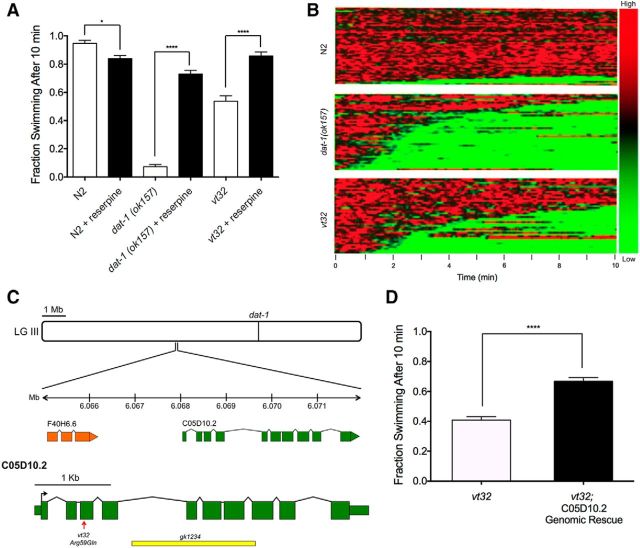Figure 1.
vt32 mutation in the gene C05D10.2 causes reserpine-sensitive Swip. A, dat-1(ok157) animals show robust Swip in water after 10 min, and vt32 animals show a more intermediate Swip phenotype. Reserpine pretreatment rescues Swip behavior in both dat-1(ok157) animals (t(190) = 16.98, p > 0.0001, Bonferroni's post-tests) and vt32 animals (t(190) = 8.29, p < 0.0001, Bonferroni's post-tests). Significance was calculated using a one-way ANOVA with Bonferroni's post-tests comparing each genotype without reserpine to the same genotype with reserpine. Significance was set at p < 0.05. *p < 0.01 ****p < 0.0001. B, Heat maps showing the swimming behavior of N2, dat-1(ok157), and vt32 animals. Each horizontal line represents the frequency of swimming over time for a single worm, going from 0 to 10 min from left to right, with red representing high-frequency values and green representing low-frequency values. N2 animals show very little paralysis, as demonstrated by the minimal green colored lines, and dat-1(ok157) animals show robust paralysis as demonstrated by the high prevalence of green lines. vt32 Animals have more intermediate paralysis. C, C05D10.2 is located on chromosome III at −1.42 cm. The vt32 mutation was located in exon 3, and results in an Arg to Gln substitution. gk1234 is a large deletion allele of C05D10.2 that deletes all of exons 5–7, and part of exon 8. D, A genomic PCR fragment containing the C05D10.2 genomic locus, including 1 kb upstream and downstream to include putative promoter and 3′ UTR sequences, was transgenically expressed in vt32 mutant animals. Comparison of transgenic and nontransgenic animals revealed a significant suppression of Swip with expression of WT C05D10.2 (t(58) = 7.83, p < 0.0001, unpaired t test). Bars represent the average of three transgenic lines with at least 100 animals per line. Significance was calculated using a two-tailed Student's t test with significance set at p < 0.05. ****p < 0.0001.

